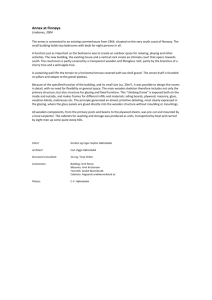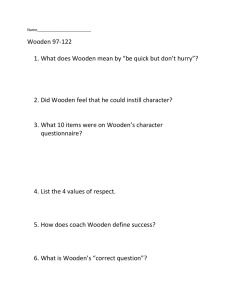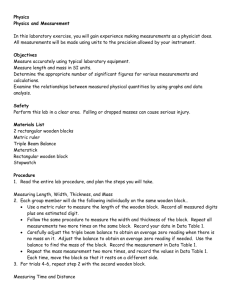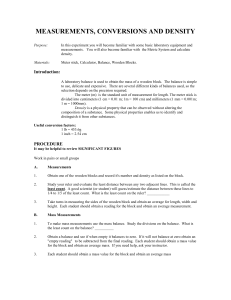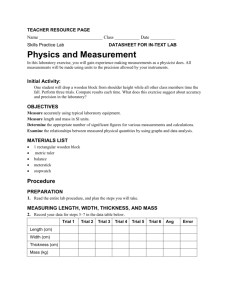Mark Wooden
advertisement
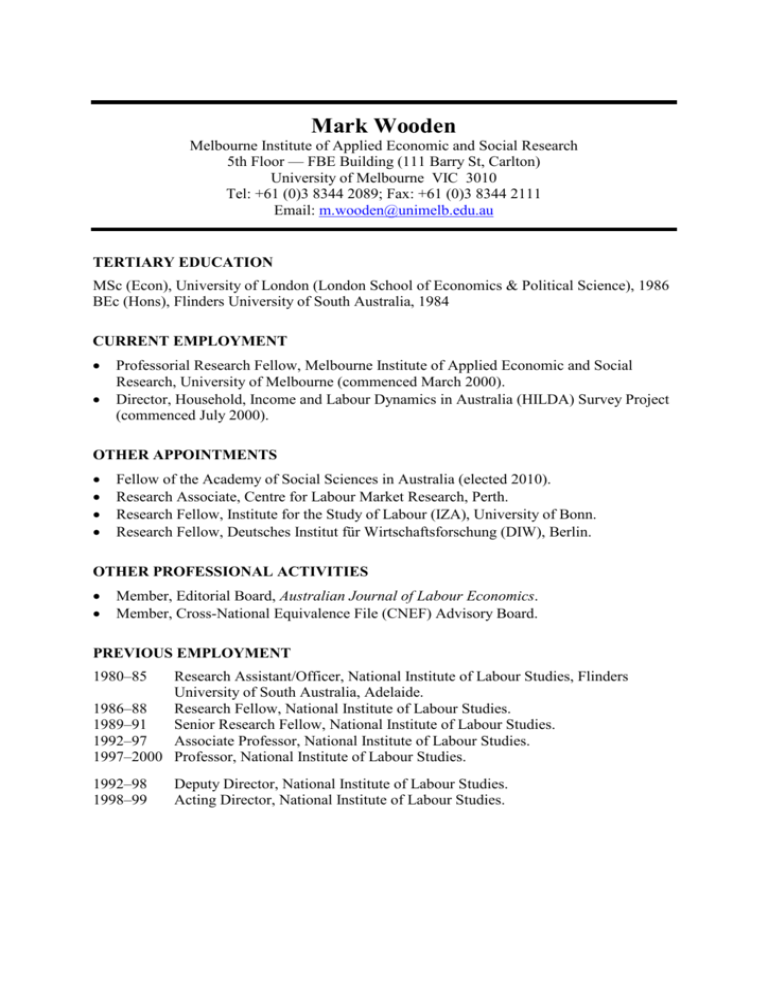
Mark Wooden Melbourne Institute of Applied Economic and Social Research 5th Floor — FBE Building (111 Barry St, Carlton) University of Melbourne VIC 3010 Tel: +61 (0)3 8344 2089; Fax: +61 (0)3 8344 2111 Email: m.wooden@unimelb.edu.au TERTIARY EDUCATION MSc (Econ), University of London (London School of Economics & Political Science), 1986 BEc (Hons), Flinders University of South Australia, 1984 CURRENT EMPLOYMENT • • Professorial Research Fellow, Melbourne Institute of Applied Economic and Social Research, University of Melbourne (commenced March 2000). Director, Household, Income and Labour Dynamics in Australia (HILDA) Survey Project (commenced July 2000). OTHER APPOINTMENTS • • • • Fellow of the Academy of Social Sciences in Australia (elected 2010). Research Associate, Centre for Labour Market Research, Perth. Research Fellow, Institute for the Study of Labour (IZA), University of Bonn. Research Fellow, Deutsches Institut für Wirtschaftsforschung (DIW), Berlin. OTHER PROFESSIONAL ACTIVITIES • • Member, Editorial Board, Australian Journal of Labour Economics. Member, Cross-National Equivalence File (CNEF) Advisory Board. PREVIOUS EMPLOYMENT 1980–85 Research Assistant/Officer, National Institute of Labour Studies, Flinders University of South Australia, Adelaide. 1986–88 Research Fellow, National Institute of Labour Studies. 1989–91 Senior Research Fellow, National Institute of Labour Studies. 1992–97 Associate Professor, National Institute of Labour Studies. 1997–2000 Professor, National Institute of Labour Studies. 1992–98 1998–99 Deputy Director, National Institute of Labour Studies. Acting Director, National Institute of Labour Studies. CV 2 Professor Mark P. Wooden PUBLICATIONS (a) Academic Journal Articles Forthcoming 1. Nattavudh Powdthavee and Mark Wooden. ‘Life Satisfaction and Sexual Minorities? Evidence from Australia and the United Kingdom.’ Journal of Economic Behavior and Organization. [Accepted April 2015] 2. John Feddersen, Rob Metcalfe and Mark Wooden, ‘Subjective Well-Being: Why Weather Matters’, The Journal of the Royal Statistical Society (Series A). [Accepted January 2015] 2015 3. David Angrave, Andy Charlwood and Mark Wooden, ‘Long Working Hours and Physical Activity’, Journal of Epidemiology & Community Health. Published Online First: 12 March. [http://dx.doi.org/10.1136/jech-2014-205230] 4. Hielke Buddelmeyer, Duncan McVicar and Mark Wooden, ‘Non-Standard “Contingent” Employment and Job Satisfaction: A Panel Data Analysis’, Industrial Relations: A Journal of Economy and Society 54(2), April, 256-275. [http://dx.doi.org/10.1111/irel.12090] 5. Nattavudh Powdthavee, Warn Lekfuangfu and Mark Wooden, ‘What’s the Good of Education on our Overall Quality of Life? A Simultaneous Equation Model of Education and Life Satisfaction for Australia’, Journal of Behavioral and Experimental Economics 54(1), February, 10-21. [http://dx.doi.org/10.1016/j.socec/2014.11.002] 2014 6. Kim M Kiely, Peter Butterworth, Nicole Watson and Mark Wooden, ‘The Symbol Digit Modalities Test: Normative Data from a Large Nationally Representative Sample of Australians’, Archives of Clinical Neuropsychology 29(8), December, 767-775. [http://dx.doi.org/10.1093/arclin/acu055] 7. Roger Wilkins and Mark Wooden, ‘Two Decades of Change: The Australian Labour Market, 1993 to 2013’, The Australian Economic Review 47(4), December, 417-431. [Invited] [http://dx.doi.org/10.1111/1467-8462.12085] 8. Seamus McGuinness, Mark Wooden and Markus Hahn, ‘The Perceived Probability of Job Loss and Future Labour Market Outcomes’, Industrial Relations Journal 45(4), July, 329-347. [http://dx.doi.org/10.1111/irj.12061] 9. David Angrave, Andy Charlwood and Mark Wooden, ‘Working Time and Cigarette Smoking: Evidence from Australia and Great Britain’, Social Science & Medicine 112, July, 72-79. [http://dx.doi.org/10.1016/j.socscimed.2014.04.031] 10. Mark Wooden and Ning Li, ‘Panel Conditioning and Subjective Well-being’, Social Indicators Research 117(1), May, pp. 235-255. [http://dx.doi.org/10.1007/s11205-013-0348-1] 11. Nicole Watson and Mark Wooden, ‘Re-engaging with Survey Non-respondents: Evidence from Three Household Panels’, Journal of the Royal Statistical Society, Series A 77(2), pp. 499-522. [http://dx.doi.org/10.1111/rssa.12024] 2 CV 3 Professor Mark P. Wooden 12. Robert Cummins and Mark Wooden, ‘Personal Resilience in Times of Crisis: The Implications of SWB Homeostasis and Set-points’, Journal of Happiness Studies 15(1), February, pp. 223235. [http://dx.doi.org/10.1007/s10902-013-9481-4] 13. Robert Cummins, Ning Li, Mark Stokes and Mark Wooden, ‘A Demonstration of Set-points for Subjective Wellbeing’, Journal of Happiness Studies 15(1), February, pp. 183-206. [http://dx.doi.org/10.1007/s10902-013-9444-9] 2013 14. Nicole Watson and Mark Wooden, ‘Adding a Top-up Sample to the HILDA Survey’, The Australian Economic Review 46(4), December, pp. 489-498. [http://dx.doi.org/10.1111/14678462.12027] 15. Rosanna Scutella, Guy Johnson, Julie Moschion, Yi-ping Tseng and Mark Wooden, ‘Understanding Lifetime Homeless Duration: Investigating Wave 1 Findings from the Journeys Home Project’, Australian Journal of Social Issues 48(1), pp. 83-110. 16. Roger Wilkins and Mark Wooden, ‘Gender Differences in Involuntary Job Loss: Why Are Men More Likely to Lose their Jobs?’ Industrial Relations: A Journal of Economy and Society 52(2), April, pp. 582-608. [http://dx.doi.org/10.1111/irel.12024] 2012 17. Nicole Watson and Mark Wooden, ‘The HILDA Survey: A Case Study in the Design and Development of a Successful Household Panel Study’, Longitudinal and Life Course Studies 3(3), October, pp. 369-381. [http://dx.doi.org/10.14301/llcs.v3i3.208] 18. Mark Wooden, Andrew Bevitt, Abraham Chigavazira, Nancy Greer, Guy Johnson, Eion Killackey, Julie Moschion, Rosanna Scutella, Yi-ping Tseng and Nicole Watson, ‘Introducing Journeys Home’, The Australian Economic Review 45(3), September, pp. 368-378. [http://dx.doi.org/10.1111/j.1467-8462.2012.00690.x] 2011 19. Robert Drago, Katina Sawyer, Karina Sheffler, Diana Warren and Mark Wooden, ‘Did Australia’s Baby Bonus Increase the Fertility Rate?’ Population Research and Policy Review 30(3), June, pp. 381-397. [http://dx.doi.org/10.1007/s11113-010-9193-y] 20. Hielke Buddelmeyer and Mark Wooden, ‘Transitions Out of Casual Employment: The Australian Experience’, Industrial Relations: A Journal of Economy and Society 50(1), January, pp. 109-130. [http://dx.doi.org/10.1111/j.1468-232X.2010.00627.x] 2010 21. Mark Wooden, ‘An Unfair Safety Net?’, Australian Bulletin of Labour 36(3), pp. 321-326. [Invited] 22. Nicole Watson and Mark Wooden, ‘The HILDA Survey: Progress and Future Developments’, Australian Economic Review 43(3), September, pp. 326-336. [http://dx.doi.org/10.1111/j.14678462.2010.00604.x] 23. Andre Renzaho, Mark Wooden and Brendan Houng, ‘Associations between Body Mass Index and Health-related Quality of Life among Australian Adults’, Quality of Life Research 19(4), May, pp. 515-520. [http://dx.doi.org/10.1007/s11136-010-9610-z] 3 CV 4 Professor Mark P. Wooden 24. Hielke Buddelmeyer, Wang-Sheng Lee and Mark Wooden, ‘Low-paid Employment and Unemployment Dynamics in Australia’, The Economic Record 86(272), March, pp. 28-48. [http://dx.doi.org/10.1111/j.1475-4932.2009.00595.x] 25. Roger Wilkins and Mark Wooden, ‘Household Debt in Australia: The Looming Crisis That Isn’t’, The Australian Economic Review 42(3), September 2009, pp. 358-366. [Invited] [http://dx.doi.org/10.1111/j.1467-8462.2009.00559.x] 2009 26. Robert Drago, Mark Wooden and David Black, ‘Long Work Hours: Volunteers and Conscripts’, British Journal of Industrial Relations 47(3), September, pp. 571-600. [http://dx.doi.org/10.1111/j.1467-8543.2009.00717.x] 27. Robert Drago, Mark Wooden and David Black, ‘Who Wants Flexibility? Changing Work Hours Preferences and Life Events’, Industrial and Labor Relations Review 62(3), April, pp. 394-414. [http://www.jstor.org/stable/25594508] 28. Seamus McGuinness and Mark Wooden, ‘Overskilling, Job Insecurity and Career Mobility: Evidence from Australia’, Industrial Relations: A Journal of Economy and Society 48(2), April, pp. 265-286. [http://dx.doi.org/10.1111/j.1468-232X.2009.00557.x] 29. Michael Shields, Stephen Wheatley Price and Mark Wooden, ‘Life Satisfaction and the Economic and Social Characteristics of Neighbourhoods’, Journal of Population Economics 22(2), April, pp. 421-443. [http://dx.doi.org/10.1007/s00148-007-0146-7] 30. Mark Wooden, Diana Warren and Robert Drago, ‘Working Time Mismatch and Subjective Well-being’, British Journal of Industrial Relations 47(1), March, pp. 147-179. [http://dx.doi.org/10.1111/j.1467-8543.2008.00705.x] 2008 31. Joachim Frick, Stephen Jenkins, Dean Lillard, Oliver Lipps and Mark Wooden, ‘Die internationale Einbettung des Sozio-oekonomischen Panels (SOEP) im Rahmen des CrossNational Equivalent File (CNEF)’, Vierteljahrshefte zur Wirtschaftsforschung (Quarterly Journal of Economic Research) 77(3), pp. 110-129. [In German] 32. Mark Wooden and Diana Warren, ‘Paid Annual Leave and Working Hours: Evidence from the HILDA Survey’, Journal of Industrial Relations 50(4), September, pp. 664-670. [http://dx.doi.org/10.1177/0022185608094118] 33. Rosanna Scutella and Mark Wooden, ‘The Effects of Household Joblessness on Mental Health’, Social Science & Medicine 67(1), July, pp. 88-100. [http://dx.doi.org/ 10.1016/j.socscimed.2008.02.025] 34. Bruce Headey, Ruud Muffels and Mark Wooden, ‘Money Doesn’t Buy Happiness: Or Does It? A Reassessment Based on the Combined Effects of Wealth, Income and Consumption’, Social Indicators Research 87(1), May, pp. 65-88. [http://dx.doi.org/10.1007/s11205-007-9146-y] 2007 35. Mark Wooden, Roger Wilkins and Seamus McGuinness, ‘Minimum Wages and the Working Poor’, Economic Papers 26(4), December, pp. 295-307. [http://dx.doi.org/10.1111/J.17593441.2007.TB01016.X] 4 CV 5 Professor Mark P. Wooden 36. Joachim Frick, Stephen Jenkins, Dean Lillard, Oliver Lipps and Mark Wooden, ‘The CrossNational Equivalent File (CNEF) and its Member Country Household Panel Studies’, Schmollers Jahrbuch: Journal of Applied Social Science Studies 127(4), pp. 627-654. 37. Mark Wooden and Nicole Watson, ‘The HILDA Survey and its Contribution to Economic and Social Research (So Far)’, The Economic Record 83(261), June, pp. 208-231. [http://dx.org.doi/10.1111/J.1475-4932.2007.00395.X] 38. Kostas Mavromaras, Seamus McGuinness and Mark Wooden, ‘Overskilling in the Australian Labour Market’, Australian Economic Review 40, September, pp. 307-312. [http://dx.doi.org/10.1111/j.1467-8462.2007.00468.x] 2006 39. Elizabeth Webster, Mark Wooden and Gary Marks, ‘Reforming the Labour Market for Australian Teachers’, Australian Journal of Education 50(2), August, pp. 185-202. [http://dx.doi.org/10.1177/000494410605000207] 40. Mark Wooden, ‘Implications of Work Choices Legislation’, Agenda: A Journal of Policy Analysis and Reform 13(2), pp. 99-116. 2005 41. Bruce Headey, Gary Marks and Mark Wooden, ‘The Dynamics of Income Poverty in Australia: Evidence from the First Three Waves of the HILDA Survey’, Australian Journal of Social Issues 40(4), Summer, pp. 541-552. 42. Bruce Headey and Mark Wooden, ‘The Importance of Wealth for Subjective Well-being’, Journal of Financial Transformation 15, December, pp. 59-67. 43. Robert Drago, David Black and Mark Wooden, ‘Female Breadwinner Families: Their Existence, Persistence and Sources’, Journal of Sociology 41(4), December, pp. 343-362. [http://dx.doi.org/ 10.1177/1440783305058465] 44. Mark Wooden, ‘Minimum Wage Setting and the Australian Fair Pay Commission’, Journal of Australian Political Economy, no. 56, December, pp. 81-91. [Invited] 45. Mark Wooden, ‘Workplace Relations Reform: Where to Now?’, The Australian Economic Review 38(2), June, pp. 176-181. [Editorial] [http://dx.doi.org/10.1111/j.14678462.2005.00364.x] 46. Bruce Headey, Gary Marks and Mark Wooden, ‘The Structure and Distribution of Household Wealth in Australia’, The Australian Economic Review 38(2), June, pp. 159-175. [http://dx.doi.org/10.1111/j.1467-8462.2005.00363.x] 47. Robert Drago, Yi-ping Tseng and Mark Wooden, ‘Usual and Preferred Working Hours in Couple Households’, Journal of Family Studies 11(1), April, pp. 46-61. 48. Elizabeth Webster, Mark Wooden and Gary Marks, ‘Teaching and the Teacher Labour Market: The Case for Reform’, Australian Economic Review 38(1), March, pp. 91-98. [http://dx.doi.org/10.1111/j.1467-8462.2005.00356.x] 49. Gary N. Marks, Bruce Headey and Mark Wooden, ‘Household Wealth in Australia: Its Components, Distribution and Correlates’, Journal of Sociology 41(1), March, pp. 47-68. [http://dx.doi.org/10.1177/1440783305050963] 5 CV 50. 6 Professor Mark P. Wooden Bruce Headey, Ruud Muffels and Mark Wooden, ‘Money and Happiness: A Reconsideration Based on the Combined Effects of Wealth, Income and Consumption’, Schmollers Jahrbuch: Journal of Applied Social Science Studies 125(1), pp. 131-144. 2004 51. Bruce Headey and Mark Wooden, ‘The Effects of Wealth and Income on Subjective Wellbeing and Ill-being’, The Economic Record 80 (Special Issue), September, pp. S24-S33. [http://dx.doi.org/10.1111/j.1475-4932.2004.00181.x] 52. Mark Wooden and Diana Warren, ‘Non-standard Employment and Job Satisfaction: Evidence from the HILDA Survey’, The Journal of Industrial Relations 46(3), September, pp. 275-297. [http://dx.doi.org/10.1111/j.0022-1856.2004.00142.x] 53. Nicole Watson and Mark Wooden, ‘The HILDA Survey Four Years On’, Australian Economic Review 37(3), September, pp. 343-349. [http://dx.doi.org/10.1111/j.1467-8462.2004.00336.x] 54. Nicole Watson and Mark Wooden, ‘Sample Attrition in the HILDA Survey’, Australian Journal of Labour Economics 7(2), June, pp. 293-308. 55. Nicole Watson and Mark Wooden, ‘The HILDA Survey: A Summary’, Australian Journal of Labour Economics 7(2), June, pp. 117-124. [Invited] 56. Bruce Headey and Mark Wooden, ‘Wealth Matters More than Income to Happiness’, Australian Social Monitor 7(2), June, pp. 49-50. 57. Rosanna Scutella and Mark Wooden, ‘Jobless Households in Australia: Incidence, Characteristics and Financial Consequences’, Economic and Labour Relations Review 14(2), January, pp. 187-207. [Invited] 2003 58. Mark Wooden, ‘Long Hours Working in Australia and Enterprise Bargaining’, Agenda: A Journal of Policy Analysis and Reform 10(3), pp. 259-271. 59. Mark Wooden, Joanne Loundes and Yi-Ping Tseng, ‘Enterprise Bargaining and Productivity in Australia: What Do We Know?’ The Economic Record 79(245), June, pp. 245-258. [http://dx.doi.org/10.1046/j.1475-4932.2003.00080.x] 2002 60. Mark Wooden, ‘Unemployment in an Age of Prosperity’, Economic and Labour Relations Review 13(2), December, pp. 179-195. [Invited] 61. Ruth Weston and Mark Wooden, ‘HILDA Has Arrived! New Survey on Australian Households and Families’, Family Matters, No. 63, Spring/Summer, pp. 66-73. [Invited] 62. Nicole Watson and Mark Wooden, ‘The HILDA Survey: What’s In It For Economists?’, Australian Journal of Labour Economics 5(3), September, pp. 397-417. 63. Mark Wooden, Simon Freidin and Nicole Watson, ‘The Household, Income and Labour Dynamics in Australia (HILDA) Survey: Wave 1’, Australian Economic Review 35(3), September, pp. 339-348. [http://dx.doi.org/10.1111/1467-8462.00252] 6 CV 7 Professor Mark P. Wooden 64. Mark Wooden, ‘Childcare Policy: An Introduction and Overview’, Australian Economic Review 35(2), June, pp. 173-179. [Editorial] [http://dx.doi.org/10.1111/1467-8462.00233] 65. Mark Wooden and Nicole Watson, ‘The Household, Income and Labour Dynamics in Australia (HILDA) Survey: An Introduction’, Australian Social Policy, 2001-02, pp. 79-99. 2001 66. Mark Wooden, ‘How Temporary are Australia’s Casual Jobs?’ Work, Employment and Society 15(4), December, pp. 875-883. [http://dx.doi.org/10.1177/095001701400438251] 67. Mark Wooden, ‘Long Working Hours: International Comparisons, Australian Social Monitor 4(4), December, pp. 102-103. 68. Mark Wooden, ‘Industrial Relations Reform in Australia: Causes, Consequences and Prospects’, The Australian Economic Review 34(3), September, pp. 243-262. [http://dx.doi.org/10.1111/1467-8462.00194] 69. Matthew James, Mark Wooden and Peter Dawkins, ‘Minimum Wages and the Fallacy of the Inflated Denominator’, Economic Papers 20(3), September, pp. 59-70. [http://dx.doi.org/10.1111/j.1759-3441.2001.tb00982.x] 70. Mark Wooden, ‘Union Wage Effects in the Presence of Enterprise Bargaining’, The Economic Record 77(236), March, pp. 1-18. [http://dx.doi.org/10.1111/1475-4932.00001] 71. Mark Wooden, ‘Are Non-standard Jobs Sub-standard Jobs?’, Australian Social Monitor 3(3), March, pp. 65-70. 72. Mark Wooden, ‘The Growth in “Unpaid” Working Time’, Economic Papers 20(1), March, pp. 29-43. [http://dx.doi.org/10.1111/j.1759-3441.2001.tb00269.x] 2000 73. Mark Cully, Richard Curtain and Adriana VandenHeuvel and Mark Wooden, ‘Participation in, and Barriers to, Training: The Experience of Older Adults’, Australasian Journal on Ageing 19(4), November, pp. 172-179. [http://dx.doi.org/ 10.1111/j.1741-6612.2000.tb00231.x] 74. Mark Wooden, ‘The Changing Skill Composition of Labour Demand’, Australian Bulletin of Labour 26(3), September, pp. 191-198. 75. Adriana VandenHeuvel and Mark Wooden, ‘Immigrants’ Labour Market Experiences in the Early Settlement Years’, Australian Bulletin of Labour 26(1), March, 59-69. 76. Mark Wooden, ‘The Labour Market in 1999: The Year in Review’, Australian Bulletin of Labour 26(1), March, pp. 3-10. [Editorial] 77. Mark Wooden and Anne Hawke, ‘Unions and Employment Growth: Panel Data Evidence’, Industrial Relations: A Journal of Economy and Society 39(1), January, pp. 88-109. [http://dx.doi.org/10.1111/0019-8676.0015410.1111/0019-8676.00154] 1999 78. Mark Wooden and Adriana VandenHeuvel, ‘Is OHS Good for Business?’ The Journal of Occupational Health & Safety – Australia & New Zealand 15(5), October, pp. 411-416. 7 CV 8 Professor Mark P. Wooden 79. Mark Wooden, ‘Individual Agreement-making in Australian Workplaces: Incidence, Trends and Features’, The Journal of Industrial Relations 41(3), September, pp. 417-445. [http://dx.org.doi/ 10.1177/002218569904100305] 80. Bijit Bora and Mark Wooden, ‘Workplace Characteristics and their Effects on Wages: Australian Evidence’, Australian Economic Papers 38(3), September, pp. 276-289. [http://dx.doi.org/10.1111/1467-8454.00057] 81. Mark Wooden, ‘The Employment Consequences of Comparable Worth Policies’, The Australian Economic Review 32(3), September, pp. 286-291. [Invited] [http://dx.doi.org/10.1111/1467-8462.00117] 82. Mark Wooden, ‘The Australian Labour Market: Preparing for the New Millennium’, Australian Bulletin of Labour 25(3), September, pp. 197-204. [Editorial] 83. Mark Wooden, ‘Outsourcing and the Use of Contractors: Evidence from the AWIRS’, The Economic and Labour Relations Review 10(1), June, pp. 22-35. [Invited] 84. Mark Wooden, ‘Gender Pay Equity and Comparable Worth in Australia: A Reassessment’, The Australian Economic Review 32(2), June, pp. 157-171. [http://dx.doi.org/10.1111/14678462.00102] 85. Mark Wooden, ‘Union Amalgamations and the Decline in Union Density’, The Journal of Industrial Relations 41(1), March, pp. 35-52. [http://dx.org.doi/10.1177/002218569904100102] 86. Mark Wooden, ‘The Labour Market in 1998: The Year in Review’, Australian Bulletin of Labour 25(1), March, pp. 3-10. [Editorial] 1998 87. Anne Hawke and Mark Wooden, ‘Industrial Relations Reform in Australia: Implications for the Agricultural and Mining Sectors’, The Australian Journal of Agricultural and Resource Economics 42(3), September, pp. 303-319. [http://dx.doi.org/10.1111/1467-8489.00053] 88. Mark Wooden, ‘Is Job Stability Really Declining?’, Australian Bulletin of Labour 24(3), September, pp. 186-193. 89. Mark Wooden, ‘Factors Associated with Inter-industry Differences in Workers’ Compensation Claims Rates’, The Journal of Occupational Health & Safety — Australia & New Zealand 14, August, pp. 349-356. 90. Mark Wooden and Anne Hawke, ‘Factors Associated with Casual Employment: Evidence from the AWIRS’, The Economic and Labour Relations Review 9(1), June, pp. 82-108. 91. Mark Wooden and Don Harding, ‘Recruitment Practices in the Private Sector: Results from a National Survey of Employers’, Asia Pacific Journal of Human Resources 36(2), pp. 73-88. [http://dx.doi.org/10.1177/103841119803600207] 92. Anne Hawke and Mark Wooden, ‘Two Steps Forward, One Step Back: Industrial Relations Developments in Australia in 1997’, Asia Pacific Journal of Human Resources 36(2), pp. 1528. [Invited] [http://dx.doi.org/10.1177/103841119803600203] 93. Anne Hawke and Mark Wooden, ‘The Changing Face of Australian Industrial Relations: A Survey’, The Economic Record 74(224), March, pp. 74-88. [http://dx.doi.org/10.1111/j.14754932.1998.tb01905.x] 8 CV 9 Professor Mark P. Wooden 1997 94. Mark Wooden and Audrey VandenHeuvel, ‘Gender Discrimination in Training: A Note’, British Journal of Industrial Relations 35(4), December, pp. 627-633. [http://dx.doi.org/10.1111/1467-8543.00072] 95. Mark Wooden, ‘The Path to Full Employment? ‘They’re Dreamin’!’, The Australian Economic Review 30(4), pp. 445-447. [Invited] [http://dx.doi.org/10.1111/1467-8462.304044] 96. Audrey VandenHeuvel and Mark Wooden, ‘Participation of Non-English-SpeakingBackground Immigrants in Work-Related Training’, Ethnic and Racial Studies 20(4), October, pp. 830-848. [http://dx.doi.org/10.1080/01419870.1997.9993991] 97. Mark Wooden and Audrey VandenHeuvel, ‘Family Composition and the Labor Supply Choices of Married Immigrant Women’, Australian Journal of Labour Economics 1(2), October, pp. 121-142. 98. Mark Wooden, ‘Enterprise Bargaining and the Gender Earnings Gap’, Australian Bulletin of Labour 23(3), September, pp. 214-226. 99. Anne Hawke and Mark Wooden, ‘The 1995 Australian Workplace Industrial Relations Survey’, The Australian Economic Review 30(3), September, pp. 323-328. [http://dx.doi.org/10.1111/1467-8462.00032] 100. Mark Wooden and Audrey VandenHeuvel, ‘Self-employed Contractors and Job Satisfaction’, Journal of Small Business Management 35(3), July, pp. 11–20. 101. Mark Wooden and Audrey VandenHeuvel, ‘NESB Immigrant Women and Part-time Work’, International Journal of Employment Studies 5(1), April, pp. 45-66. 102. Mark Wooden, ‘Employer Knowledge of, and Satisfaction with, ITABs: Survey Evidence’, Australian Vocational Education Review 4(1), pp. 38-51. 1996 103. Meredith Baker and Mark Wooden, ‘Formal Training for Employees of Small Business’, Small Enterprise Research: The Journal of SEAANZ 4(1/2), pp. 108-125. 104. Mark Wooden, ‘Firm Size and the Provision of Employee Training: An Analysis of the 1993 Survey of Training and Education’, Australian and New Zealand Journal of Vocational Education Research 4(2), November, pp. 89-120. 105. Mark Wooden and Audrey VandenHeuvel, ‘The Use of Contractors in Australian Workplaces’, Labour Economics and Productivity 8(2), October, pp. 163-194. 106. Mark Wooden, ‘The Youth Labour Market: Characteristics and Trends’, Australian Bulletin of Labour 22(2), June, pp. 137-160. 107. Meredith Baker, Mark Wooden and Peter Kenyon, ‘Training in Small and Medium Enterprises: Is Australia’s National Training Reform Agenda Appropriate?’, Labour Economics and Productivity 8(1), March, 1-24. 9 CV 10 Professor Mark P. Wooden 1995 108. Mark Wooden, ‘Labour Absence in Australia: An Overview of Dimensions, Causes and Remedial Strategies’, Australian Bulletin of Labour 21(4), December, pp. 323-339. 109. Jeffrey Balchin and Mark Wooden, ‘Absence Penalties and Work Attendance’, The Australian Economic Review, No. 112, 4th Quarter, pp. 43-58. [http://dx.doi.org/ 10.1111/j.14678462.1995.tb00903.x] 110. Audrey VandenHeuvel and Mark Wooden, ‘Do Explanations of Absence Differ for Men and Women?’, Human Relations 48(11), November, pp. 1309-1329. [http://dx.doi.org/ 10.1177/001872679504801104] 111. Robert Bush and Mark Wooden, ‘Smoking Cessation and Absence from Work’, Preventive Medicine 24(5), September, pp. 535-540. [http://dx.doi.org/10.1006/pmed.1995.1084] 112. Robert Bush and Mark Wooden, ‘Smoking and Absence from Work: Australian Evidence’, Social Science and Medicine 41(3), August, pp. 437-446. [http://dx.doi.org.ezp.lib.unimelb.edu.au/10.1016/0277-9536(94)00350-3] 113. Audrey VandenHeuvel and Mark Wooden, ‘Self-employed Contractors in Australia: How Many and Who Are They?’, The Journal of Industrial Relations 37(2), June, pp. 263-280. [http://dx.org.doi/ 10.1177/002218569503700204] 114. Mark Wooden, ‘Penalty Rates and Labour Supply’, The Journal of Industrial Relations 37(2), June, pp. 297-301. [http://dx.org.doi/ 10.1177/002218569503700206] 115. Mark Wooden, ‘Training Data and Statistics in Australia’, The Australian Economic Review, No. 110, 2nd Quarter, pp. 116-120. [Invited] [http://dx.doi.org/10.1111/j.14678462.1995.tb00896.x] 116. Robert Drago and Mark Wooden, ‘A Disaggregated Approach to the Study of Absence from Work’, Labour and Industry 6(2), March, pp. 45-66. [http://dx.doi.org/10.1080/10301763.1995.10669134] 1994 117. Sean Kennedy, Robert Drago, Judith Sloan and Mark Wooden, ‘The Effect of Trade Unions on the Provision of Training: Australian Evidence’, British Journal of Industrial Relations 32(4), December, pp. 565-580. [http://dx.doi.org/ 10.1111/j.1467-8543.1994.tb01051.x] 118. Mark Wooden, Frances Robertson and Peter Dawkins, ‘Part-time Employment and Participation and Retention in Higher Education’, Australian Journal of Education 38(3), November, pp. 250-265. [http://dx.doi.org/10.1177/000494419403800305] 119. Mark Wooden and Meredith Baker, ‘Trade Unions and Quits in Australia’, Journal of Labor Research 15(4), Fall, pp. 403-418. [http://dx.doi.org/10.1007/BF02685706] 120. Peter Kenyon and Mark Wooden, ‘The Outlook for Labour Supply in Australia During the 1990s’, Labour Economics and Productivity 6(2), September, pp. 130-155. 121. Robert Drago and Mark Wooden, ‘Unions, Investment and Innovation: Australian Evidence’, Applied Economics 26(6), June, pp. 609-615. [http://dx.doi.org/10.1080/00036849400000031] 10 CV 11 Professor Mark P. Wooden 122. Lawson Savery and Mark Wooden, ‘The Relative Influence of Life-Events and Hassles on Work-related Injuries: Some Australian Evidence’, Human Relations 47(3), March, pp. 283306. [http://dx.doi.org/10.1177/001872679404700303] 123. Mark Wooden, ‘The Green Paper on Employment Opportunities, or Don’t You Worry About That’, The Australian Economic Review, No. 105, 1st Quarter, pp. 6-10. [Invited] [http://dx.doi.org/10.1111/j.1467-8462.1994.tb00818.x] 1993 124. Judith Sloan and Mark Wooden, ‘A Case for Public Sector Job Creation Schemes? Not Really’, The Economic and Labour Relations Review 4(2), December, pp. 328-332. 125. Mark Wooden, ‘Overemployment, Unemployment and the Work Sharing Debate’, Australian Bulletin of Labour 19(4), December, pp. 296-303. 126. Robert Drago and Mark Wooden, ‘Do Union Voice and Worker Participation Coincide? A Study of Australian Managers’ Perceptions’, Economic and Industrial Democracy 14(4), November, pp. 573-588. [http://dx.doi.org/10.1177/0143831X93144006] 127. Mark Wooden and Jeffrey Balchin, ‘Unionization in Australia: Evidence from the AWIRS’, The Economic Record 69(206), September, pp. 305-314. [http://dx.doi.org/10.1111/j.14754932.1993.tb02110.x] 128. Mark Wooden, ‘Underemployment in Australia’, Labour Economics and Productivity 5(2), September, pp. 95-110. 1992 129. Robert Drago, Saul Estrin and Mark Wooden, ‘Pay for Performance Incentives and Work Attitudes’, Australian Journal of Management 17(2), December, pp. 217-231. 130. Mark Wooden, ‘Compulsory Unionism and the AWIRS: Redrawing the Map’, The Economic and Labour Relations Review 3(2), December, pp. 180-198. 131. Mark Wooden, ‘The Cost of Time Off Work in Australia’, Asia Pacific Journal of Human Resources 30(3), Spring, pp. 1-10. [http://dx.doi.org/10.1177/103841119303000301] [Reprinted in Raymond J. Stone (ed.), Readings in Human Resource Management: Volume Two.] 132. Robert Drago and Mark Wooden, ‘The Determinants of Labour Absence: Economic Factors and Workgroup Norms Across Countries’, Industrial and Labor Relations Review 45(4), July, pp. 764-778. [http://dx.doi.org/10.2307/2524592] 133. Meredith Baker and Mark Wooden, ‘Immigration and its Impact on the Incidence of Training in Australia’, The Australian Economic Review, No. 98, 2nd Quarter, pp. 39-53. [http://dx.doi.org/ 10.1111/j.1467-8462.1992.tb00582.x] 134. Dale Belman, Robert Drago and Mark Wooden, ‘Workgroups, Efficiency Wages and Work Effort’, Journal of Post-Keynesian Economics 14(4), Summer, pp. 497-521. [http://www.jstor.org/stable/4538312] 135. Robert Drago and Mark Wooden, ‘The Australian Workplace Industrial Relations Survey and Workplace Performance’, Australian Bulletin of Labour 18(2), June, pp. 142-67. 11 CV 12 Professor Mark P. Wooden 136. Meredith Baker and Mark Wooden, ‘Training in the Australian Labour Market: Evidence from the How Workers Get Their Training Survey’, Australian Bulletin of Labour 18(1), March, pp. 26-46. 1991 137. Mark Wooden, ‘The Experience of Refugees in the Australian Labor Market’, International Migration Review 25(3), Fall, pp. 514-535. [http://dx.doi.org/ 10.2307/2546758] 138. Robert Drago and Mark Wooden, ‘The Determinants of Participatory Management’, British Journal of Industrial Relations 29(2), June, pp. 177-204. [http://dx.doi.org/ 10.1111/j.14678543.1991.tb00236.x] 139. Robert Drago and Mark Wooden, ‘Turnover Down Under: Trade Unions and Exit Behaviour in Australia’, The Journal of Industrial Relations 33(2), June, pp. 234-248. [http://dx.org.doi/10.1177/002218569103300205] 140. Mark Wooden, ‘Grievance and Dispute Procedures: A Note on the Importance of Compliance’, Labour Economics and Productivity 3(1), March, pp. 61-71. 1990 141. Mark Wooden, ‘The “Sickie”: A Public Sector Phenomenon?’, The Journal of Industrial Relations 32(4), December, pp. 560-576. [http://dx.org.doi/10.1177/002218569003200406] 142. Mark Wooden and Judith Sloan, ‘Award Restructuring: Factors Associated with its Progress and Success’, Labour and Industry 3(2/3), June / October, pp. 215-234. [http://dx.doi.org/10.1080/10301763.1990.10669086] 143. Robert Drago and Mark Wooden, ‘The BCA Report: A Response to Frenkel and Peetz (II)’, The Journal of Industrial Relations 32(3), September, pp. 413-418. [http://dx.org.doi/10.1177/002218569003200307] 144. Judith Sloan and Mark Wooden, ‘The Structural Efficiency Principle in Action – Management Views’, Australian Bulletin of Labour 16(3), September, pp. 199-223. 145. Judith Sloan and Mark Wooden, ‘Trade Union Structure and Workplace Efficiency: An Agenda for Reform’, Australian Quarterly 62(3), Spring, pp. 206-216. [http://dx.doi.org/10.2307/20635588] 146. Roy Kriegler and Mark Wooden, ‘Labour Absence and Turnover in Australia’, Asia Pacific HRM 28(3), August, pp. 53-61. [http://dx.doi.org/10.1177/103841119002800305] 147. Mark Wooden, ‘Corporatism and Wage Setting: The Accord in Hindsight’, Economic Papers 9(2), June, pp. 51-63. [http://dx.doi.org/10.1111/j.1759-3441.1990.tb00600.x] 148. Mark Wooden, ‘Employee Participation – A Practical Guide’, Australian Bulletin of Labour 16(2), June, pp. 90-103. [Reprinted in Raymond J. Stone (ed.), Readings in Human Resource Management.] 149. Mark Wooden, ‘Are Australian Trade Unions Good for Productivity?’, Asia Pacific HRM 28(2), May, pp. 81-86. [http//:dx.doi.org/ 10.1177/103841119002800208] 12 CV 13 Professor Mark P. Wooden 150. Mark Wooden, ‘Factors Associated with Workplace Accidents: Evidence from the 1983 Health Survey’, The Journal of Occupational Health and Safety – Australia and New Zealand 6(2), April, pp. 97-102. 151. Robert Drago and Mark Wooden, ‘The Determinants of Strikes in Australia’, The Journal of Industrial Relations 32(1), March, pp. 32-52. [http://dx.org.doi/10.1177/002218569003200103] [Reprinted in Braham Dabscheck, Gerard Griffin, and Julian Teicher (eds), Contemporary Australian Industrial Relations Readings.] 1989 152. Mark Wooden, ‘Workers’ Compensation, Unemployment and Industrial Accidents: An Intertemporal Analysis’, Australian Economic Papers 28(53), December, pp. 219-235. [http://dx.doi.org/10.1111/j.1467-8454.1989.tb00481.x] 153. Richard Blandy, Judith Sloan and Mark Wooden, ‘Reforming the Trade Union Structure in Australia’, Australian Bulletin of Labour 15(5), December, pp. 370-83. [Reprinted in Lawson Savery and Norman Dufty (eds), Readings in Australian Industrial Relations.] 154. Mark Wooden, Peter Dawkins and Roy Kriegler, ‘Towards Organizational Effectiveness: An Overview with an Australian Perspective’, Australian Bulletin of Labour 15(2), March, pp. 115-38. 155. Mark Wooden ‘The Extent of Labour Absence in Australia: Some Evidence from the Labour Force Survey’, Labour Economics and Productivity 1(1), March, pp. 53-65. 156. Mark Wooden and Narmon Tulsi, ‘The Measurement of Injury Risk Across Industries’, The Journal of Occupational Health and Safety – Australia and New Zealand 5(1), February, pp. 15-19. 1988 157. Mark Wooden, ‘The Impact of Redundancy on Subsequent Labour Market Experience’, The Journal of Industrial Relations 30(1), March, pp. 3-31. [http://dx.org.doi/10.1177/002218568803000101] 1987 158. Mark Wooden and Judy Sloan, ‘Plant Shutdown: A Case-Study in Managed Change’, Australian Bulletin of Labour 14(1), December, pp. 358-81. 1985 159. Mark Wooden, ‘Achieving Consensus in a Pluralist Society: Realisable Goal or Wishful Thinking?’, Journal of Australian Political Economy, No. 19, December, pp. 14-28. 160. Peter Dawkins and Mark Wooden, ‘Labour Utilization and Wage Inflation in Australia: An Empirical Examination’, The Economic Record 61(173), June, pp. 516-521. [http://dx.doi.org/10.1111/j.1475-4932.1985.tb02006.x] 161. Stephen Creigh and Mark Wooden, ‘Strikes in Post-War Australia: A Review’, The Journal of Industrial Relations 27(2), June, pp. 131-157. [http://dx.org.doi/10.1177/002218568502700201] 162. Roy Kriegler and Mark Wooden, ‘New Technology: The Challenge to Industrial Relations’, Current Affairs Bulletin 61(11), April, pp. 16-27. 13 CV 14 Professor Mark P. Wooden 1984 163. Judith Sloan and Mark Wooden, ‘Labour Markets from the Microeconomic Perspective: Implicit Contract Theory’, The Australian Economic Review, No. 67, 3rd Quarter, pp. 120-129. [Invited] [http://dx.doi.org/ 10.1111/j.1467-8462.1984.tb00463.x] 1983 164. Stephen Creigh, Frances Robertson and Mark Wooden, ‘Research Note: Inter-State Variations in Strike Proneness’, Australian Bulletin of Labour 9(3), June, pp. 208-16. (b) Books 1. Mark Wooden, The Transformation of Australian Industrial Relations, Federation Press, Leichhardt (Sydney), 2000. 2. Robert Drago, Mark Wooden and Judith Sloan, Productive Relations? Australian Industrial Relations and Workplace Performance, Allen and Unwin, Sydney, 1992. 3. Mark Wooden, Robert Holton, Graeme Hugo and Judith Sloan, Australian Immigration: A Survey of the Issues, AGPS, Canberra, 1990. [Updated and revised second edition published in 1994.] 4. Roy Kriegler, Peter Dawkins, Jane Ryan and Mark Wooden, Achieving Organizational Effectiveness: Case Studies in the Australian Service Sector, Oxford University Press, Melbourne, 1988. (c) Other Monographs 1. Hielke Buddelmeyer, Felix Leung, Duncan McVicar and Mark Wooden, Training and its Impact on the Casual Employment Experience, National Centre for Vocational Education Research, Adelaide, 2013. 2. Bill Martin, Belinda Hewitt, Marian Baird, Janeen Baxter, Alexandra Heron, Gillian Whitehouse, Maria Zadioroznyj, Ning Xiang, Dorothy Broom, Likue Connelly, Andrew Jones, Guyonne Kalb, Duncan McVicar, Lyndall Strazdins, Margaret Walter, Mark Western and Mark Wooden, Paid Parental Leave Evaluation: Phase 1 (Occasional Paper no. 44), Department of Families, Housing, Community Services and Indigenous Affairs, Canberra, 2012. 3. Bruce Headey, Diana Warren and Mark Wooden, The Structure and Distribution of Household Wealth in Australia: Cohort Differences and Retirement Issues (Social Policy Research Paper 33), Department of Families, Housing, Community Services and Indigenous Affairs, Canberra, 2008. 4. Adriana VandenHeuvel and Mark Wooden, New Settlers Have Their Say — How Immigrants Fare Over the Early Settlement Years: An Analysis of Data from Three Waves of the Longitudinal Survey of Immigrants to Australia (Report prepared for the Department of Immigration and Multicultural Affairs, Canberra), AusInfo, Canberra, 1999. 5. Mark Wooden, Adriana VandenHeuvel and Rebecca Goodes, OHS Activity and Firm Performance: A Review of the Literature, National Occupational Health & Safety Commission, Sydney, 1999. 14 CV 6. 15 Professor Mark P. Wooden Adriana VandenHeuvel and Mark Wooden, Casualisation and Outsourcing: Trends and Implications for Work-related Training, National Centre for Vocational Education Research, Adelaide, 1999. 7. Mark Wooden, Impediments to the Employment of Young People, National Centre for Vocational Education Research, Adelaide, 1999. 8. Mark Wooden, The Role of Industry Training Advisory Bodies (ITABs), National Training Markets Research Centre Monograph No. 2, National Centre for Vocational Education Research, Adelaide, 1997. 9. Audrey VandenHeuvel and Mark Wooden, The Experience of Immigrants in Work-related Training, AGPS, Canberra, 1996. 10. Audrey VandenHeuvel and Mark Wooden Non-English-Speaking-Background Immigrant Women and Part-time Work, AGPS, Canberra, 1996. 11. Keith Norris and Mark Wooden (eds), The Changing Australian Labour Market, EPAC Commission Paper No. 11, AGPS, Canberra, 1996. 12. Meredith Baker and Mark Wooden (eds), Small and Medium-Sized Enterprises and Vocational Education and Training, National Training Markets Research Centre, Monograph No. 1, NCVER, Adelaide, 1995. 13. Mark Wooden, Underemployment, Hidden Unemployment and Immigration, AGPS, Canberra, 1993. 14. Mark Wooden, Workplace Industrial Relations in the Service Sector, Service Industries Research Program, Report No. 8, November 1992, DITAC / ACSI, Canberra. 15. Meredith Baker and Mark Wooden, Immigrant Workers in the Communication Industry, AGPS, Canberra, 1992. 16. Meredith Baker and Mark Wooden, Immigration and Training, AGPS, Canberra, 1991. 17. Mark Wooden, Migrant Labour Market Status, AGPS, Canberra, 1990. 18. Peter Dawkins, Frances Robertson and Mark Wooden (with Meredith Baker, Garry Goddard and Peter Kain), The Employment Potential of Recreation, Sport and Fitness, Report to the Sport and Recreation Ministers Council, Commonwealth of Australia, Canberra, 1987. (d) Book Chapters 1. Roger Wilkins and Mark Wooden, ‘The Changing Australian Labour Market at the Start of the 21st Century’, in Katherine Barnes and Peter Spearitt (eds), Drivers of Change for the Australian Labour Market to 2030: Proceedings of an Expert Scenario Forum, The Academy of Social Sciences in Australia, Canberra, 2014, pp. 55-72. 2. Rosanna Scutella and Mark Wooden, ‘Dynamics of Homelessness’, in Chris Chamberlain, Guy Johnson and Catherine Robinson (eds), Homelessness in Australia: An Introduction, NewSouth Publishing, Sydney, 2014, pp. 46-66. 3. Mark Wooden, ‘Working Time and the Quality of Life’, in Alex C. Michalos (ed.), Encyclopedia of Quality of Life and Well-Being Research, Springer, Dordercht (Netherlands), 2014, pp. 7198-7203. 15 CV 16 Professor Mark P. Wooden 4. Roger Wilkins and Mark Wooden, ‘Economic Approaches to Studying Underemployment’, in Daniel Feldman and Douglas Maynard (eds), Underemployment: Psychological, Economic, and Social Challenges, Springer, New York, 2011, pp. 13-34. 5. Robert Drago and Mark Wooden, ‘Work Hours Mismatch in the U.S. and Australia’, in Barbara Schneider and Kathleen Christensen (eds), Workplace Flexibility: Realigning 20th Century Jobs to the 21st Century, Cornell University Press, Ithaca (NY), 2010, pp. 262-275. 6. Mark Wooden and Robert Drago, ‘The Changing Distribution of Working Hours in Australia’, in Jenny Corbett, Anne Daly, Hisakazu Matsushige and Dehne Taylor (eds), Laggards and Leaders in Labour Market Reform: Comparing Japan and Australia, Routledge, Abingdon (UK), 2009, pp. 67-81. 7. Nicole Watson and Mark Wooden, ‘Identifying Factors Affecting Longitudinal Survey Response’, in Peter Lynn (ed.), Methodology of Longitudinal Surveys, John Wiley and Sons, Chichester, 2009, pp. 157-181. 8. Bruce Headey and Mark Wooden, ‘Economic Wellbeing and Subjective Wellbeing: The Effects of Income and Wealth’, in Lenore Manderson (ed.), Rethinking Well-being: Essays on Health, Disability and Disadvantage, Australian Public Intellectual Network, Curtin University, Perth, 2005, pp. 91-108. 9. Bruce Headey and Mark Wooden, ‘Income, Wealth and Joblessness: Insights from the HILDA Survey’, in Peter Dawkins and Michael Stutchbury (eds), Sustaining Prosperity, Melbourne University Press, Melbourne, 2005, pp. 60-93. 10. Mark Wooden, ‘Work and Family’, in Peter Dawkins and Mike Steketee (eds), Reforming Australia: New Policies for a New Generation, Melbourne University Press, Melbourne, 2004, pp. 44-59. 11. Mark Wooden, ‘The Changing Labour Market and its Impact on Work and Employment Relations’, in Ron Callus and Russell Lansbury (eds), Working Futures: The Changing Nature of Work and Employment Relations in Australia, Federation Press, Sydney, 2002, pp. 51-69. 12. Mark Wooden and Bijit Bora, ‘The Importance of Where you Work for Wage Outcomes’, in Richard Gough, Michael Alexander and James Doughney (eds), What’s Happening at Work? Reports from the Australian Workplace Industrial Relations Survey 1990 and 1995, Common Ground Publishing, Altona (Melbourne), 2001, pp. 129-144. 13. Mark Wooden, ‘Efficiency in Markets: Labour and Industrial Relations’, in Peter Lloyd, Margaret Mead and John Nieuwenhuysen (eds), Reshaping Australia’s Economy: Growth with Equity and Sustainability, Cambridge University Press, Melbourne, 2001, pp. 229-241. 14. Mark Wooden, ‘Commentary on Roy Green — Industrial Relations Legislation: All Dressed Up and Nowhere to Go’, in Ian Hunt and Chris Provis (eds), The New Industrial Relations: An Inter-disciplinary Critique, Federation Press, Sydney, 1995, pp. 172-176. 15. Mark Wooden, ‘The Cost of Time Off Work in Australia’, in Raymond J. Stone (ed.), Readings in Human Resource Management: Volume Two, John Wiley & Sons, Brisbane, 1994, pp. 327335. 16. Robert Drago and Mark Wooden, ‘The Determinants of Strikes in Australia’, in Braham Dabscheck, Gerard Griffin and Julian Teicher (eds), Contemporary Australian Industrial Relations Readings, Longman Cheshire, Sydney, 1992, pp. 88-108. 16 CV 17 Professor Mark P. Wooden 17. Mark Wooden, ‘Employee Participation – A Practical Guide’, in Raymond J. Stone (ed.), Readings in Human Resource Management, Jacaranda Wiley, Brisbane, 1991, pp. 170-178. 18. Richard Blandy, Judith Sloan and Mark Wooden, ‘Reforming the Trade Union Structure in Australia’, in Lawson Savery and Norman Dufty (eds), Readings in Australian Industrial Relations, Harcourt Brace Jovanovich, Sydney, 1991, pp. 205-217. 19. Mark Wooden, ‘The Economic Impact of Immigration’, in Mark Wooden, Robert Holton, Graeme Hugo and Judith Sloan, Australian Immigration: A Survey of the Issues, AGPS, Canberra, 1990, pp. 110-157. [Pp. 111-157 in updated/revised second edition published in 1994.] 20. Mark Wooden, ‘The Labour Market Experience of Immigrants’, in Mark Wooden, Robert Holton, Graeme Hugo and Judith Sloan, Australian Immigration: A Survey of the Issues, AGPS, Canberra, 1990, pp. 227-292. [Pp. 218-279 in updated/revised second edition published in 1994.] 21. David Evans and Mark Wooden ‘The Scope and Nature of S.A. Public Sector Activity’, in Richard Blandy and Cliff Walsh (eds), Budgetary Stress: The South Australian Experience, Allen and Unwin, Sydney, 1989, pp. 45-88. 22. Mark Wooden, ‘Natural Resources’, in Richard Blandy and Cliff Walsh (eds), Budgetary Stress: The South Australian Experience, Allen and Unwin, Sydney, 1989, pp. 266-290. 23. Judith Sloan and Mark Wooden, ‘Labour Market Programs’, in John Freebairn, Michael Porter and Cliff Walsh (eds), Spending and Taxing: Australian Reform Options, Allen and Unwin, Sydney, 1987, pp. 146-165. 24. Richard Blandy, Ian Amstad, Geoff Bannister, Meredith Baker, Anita Quagliata and Mark Wooden, ‘Industrial Relations Systems and Competitiveness’, in Richard Blandy and John Niland (eds), Alternatives to Arbitration, Allen and Unwin, Sydney, 1986, pp. 63-80. (e) Contributions to Other Edited Works 1. Mark Wooden and Markus Hahn, ‘Female Breadwinner Families’, in Roger Wilkins (ed.), Families, Incomes and Jobs, Volume 9: A Statistical Report on Waves 1 to 11 of the Household, Income and Labour Dynamics in Australia Survey, Melbourne Institute of Applied Economic and Social Research, University of Melbourne, 2014, pp. 57-60. 2. Mark Wooden and Yin-King Fok, ‘Working at Home: Whatever Happened to the Revolution’, in Roger Wilkins (ed.), Families, Incomes and Jobs, Volume 8: A Statistical Report on Waves 1 to 10 of the Household, Income and Labour Dynamics in Australia Survey, Melbourne Institute of Applied Economic and Social Research, University of Melbourne, 2013, pp. 106-113. 3. Mark Wooden, ‘Hours of Work and Job Mobility’, in Roger Wilkins and Diana Warren, Families, Incomes and Jobs, Volume 7: A Statistical Report on Waves 1 to 9 of the Household, Income and Labour Dynamics in Australia Survey, Melbourne Institute of Applied Economic and Social Research, University of Melbourne, 2012, pp. 155-156. 4. Mark Wooden, ‘The Stability of Personality Traits’, in Roger Wilkins and Diana Warren, Families, Incomes and Jobs, Volume 7: A Statistical Report on Waves 1 to 9 of the Household, Income and Labour Dynamics in Australia Survey, Melbourne Institute of Applied Economic and Social Research, University of Melbourne, 2012, pp. 157-158. 5. Mark Wooden, ‘How Unhealthy are the Overweight’, in Roger Wilkins, Diana Warren, Markus Hahn and Brendan Houng, Families, Incomes and Jobs, Volume 5: A Statistical Report on 17 CV 18 Professor Mark P. Wooden Waves 1 to 7 of the Household, Income and Labour Dynamics in Australia Survey, Melbourne Institute of Applied Economic and Social Research, University of Melbourne, 2010, pp. 110115. 6. Mark Wooden and Markus Hahn, ‘Long Hours of Work and its Consequences’, in Roger Wilkins, Diana Warren and Markus Hahn, Families, Incomes and Jobs, Volume 4: A Statistical Report on Waves 1 to 6 of the HILDA Survey, Melbourne Institute of Applied Economic and Social Research, University of Melbourne, 2009, pp. 196-201. 7. Mark Wooden, ‘Government Can’t Close the Gender Pay Gap’, in Justin Healey (ed.), Gender Equality: Issues in Society, Volume 286, The Spinney Press, Thirroul (NSW), 2009, pp. 28-29. 8. Adriana VandenHeuvel and Mark Wooden, ‘Diversity in Employment Arrangements’, in John Mangan (ed.), Understanding and Reducing Unemployment: National and State Perspectives, Office of Economic and Statistical Research, Queensland Treasury, Brisbane, 2000, pp. 69-83. 9. Mark Wooden and Adriana VandenHeuvel, ‘The Labour Market for Young Adults’, in Dusseldorp Skills Forum, Australia’s Young Adults: The Deepening Divide, Dusseldorp Skills Forum, Sydney, 1999, pp. 35-53. 10. Mark Wooden, ‘Employer Perceptions of Industry Training Advisory Boards: Survey Evidence’, in Fran Ferrier and Damon Anderson (eds), Different Drums, One Beat? Economic and Social Goals in Education and Training, National Centre for Vocational Education and Research, Adelaide, 1998, pp. 208-218. 11. Mark Wooden, ‘The Labour Market for Young Australians’, in Dusseldorp Skills Forum, Australia’s Youth: Reality and Risk, Dusseldorp Skills Forum, Sydney, 1998, pp. 29-50. 12. Peter Kenyon and Mark Wooden, ‘Labour Supply’, in Keith Norris and Mark Wooden (eds), The Changing Australian Labour Market, EPAC Commission Paper No. 11, AGPS, Canberra, 1996, pp. 15-38. 13. Robert Drago and Mark Wooden, ‘Explaining and Managing Labour Absence in Australia’, in Alison Preston and Peter Reidell (eds), Managing Absenteeism: Analysing and Preventing Labour Absence, Industrial Relations Research Series No. 18, Department of Industrial Relations, Canberra, 1995, pp. 61-140. 14. Robert Drago and Mark Wooden, ‘The Links Between Economic Performance and Industrial Relations: Evidence from AWIRS’, in Industrial Relations and Workplace Productivity, Industrial Relations Research Series No. 2, August 1992, Department of Industrial Relations, pp. 53-98. 15. Roy Kriegler, Mark Wooden and Robert Drago, ‘Employee and Industrial Relations in Australian Companies: A Survey of Management’, in Business Council of Australia Industrial Relations Study Commission, Enterprise Based Bargaining Units: A Better Way of Working, Business Council of Australia, Melbourne 1989. 18

